Special Report
This Is the City in Every State Where COVID-19 Is Growing the Fastest
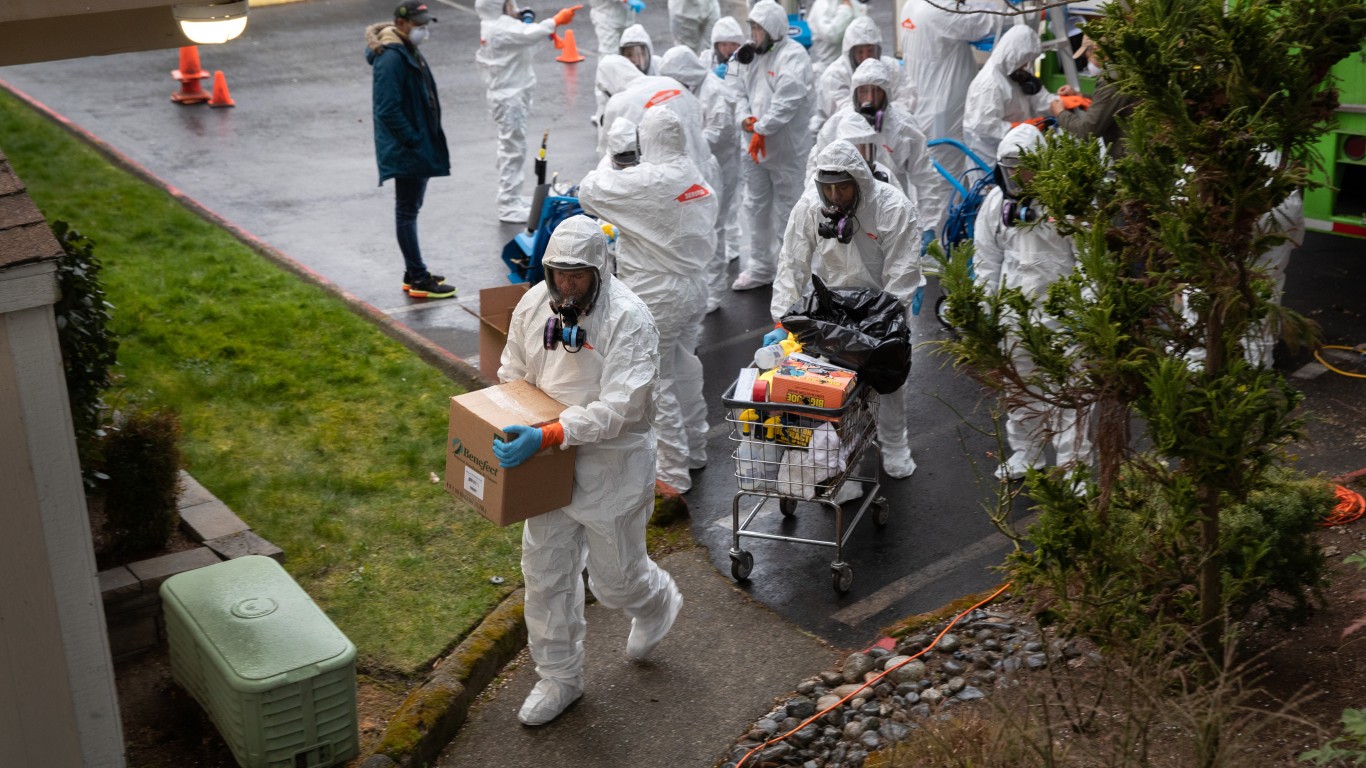
Published:

The U.S. has reported more than 27,000,000 confirmed COVID-19 cases as of Feb. 15. There have been more than 470,000 reported deaths from COVID-19-related causes — the highest death toll of any country.
The extent of the spread of the novel coronavirus continues to vary considerably from state to state, and from city to city. Even as the number of daily new cases is flattening or even declining in some parts of the country, it is surging at a growing rate in others.
Nationwide, the number of new cases is growing at a slowing rate. There were an average of 31.1 daily new coronavirus cases per 100,000 Americans in the week ending Feb. 15, a decrease from the week prior, when there were an average of 43.5 daily new coronavirus cases per 100,000 people.
Metropolitan areas with a high degree of mobility and a large population may be particularly vulnerable to outbreaks. While science and medical professionals are still studying how exactly the virus spreads, experts agree that outbreaks are more likely to occur in group settings where large numbers of people routinely have close contact with one another. Cities with high concentrations of dense spaces such as colleges, correctional facilities, and nursing homes are particularly at risk.
The city with the highest seven-day average of new daily COVID-19 cases per capita is in Texas. In the Odessa, TX, metro area, there were an average of 99.3 daily new coronavirus cases per 100,000 residents in the week ending Feb. 15, the most of any U.S. metro area. Other cities where COVID-19 is growing the fastest include Spartanburg, SC; Hot Springs, AR; and Myrtle Beach-Conway-North Myrtle Beach, SC-NC.
To determine the metropolitan area in each state where COVID-19 is growing the fastest, 24/7 Wall St. compiled and reviewed data from state and local health departments. We ranked metropolitan areas according to the average number of new daily COVID-19 cases per 100,000 residents in the seven days ending Feb. 15. Data was aggregated from the county level to the metropolitan area level using boundary definitions from the U.S. Census Bureau. Population data used to adjust case and death totals came from the U.S. Census Bureau’s 2018 American Community Survey and are five-year estimates. Unemployment data is from the Bureau of Labor Statistics and is seasonally adjusted.

Alabama: Anniston-Oxford
Avg. new daily cases in Anniston in week ending Feb. 15: 37.1 per 100,000
Avg. new daily cases in Anniston in week ending Feb. 8: 52.4 per 100,000
COVID-19 cases in Anniston as of Feb. 15: 12,725 (11,055.8 per 100,000)
Peak pandemic unemployment in Anniston: 18.7% (April 2020)
Anniston population: 115,098 (190.0 people per sq. mi.)

Alaska: Anchorage
Avg. new daily cases in Anchorage in week ending Feb. 15: 0.1 per 100,000
Avg. new daily cases in Anchorage in week ending Feb. 8: 0.1 per 100,000
COVID-19 cases in Anchorage as of Feb. 15: 20,224 (5,061.4 per 100,000)
Peak pandemic unemployment in Anchorage: 14.8% (April 2020)
Anchorage population: 399,576 (15.2 people per sq. mi.)
These are all the counties in Alaska where COVID-19 is slowing (and where it’s still getting worse).

Arizona: Phoenix-Mesa-Chandler
Avg. new daily cases in Phoenix in week ending Feb. 15: 41.1 per 100,000
Avg. new daily cases in Phoenix in week ending Feb. 8: 58.0 per 100,000
COVID-19 cases in Phoenix as of Feb. 15: 543,900 (11,637.6 per 100,000)
Peak pandemic unemployment in Phoenix: 12.8% (April 2020)
Phoenix population: 4,673,634 (320.9 people per sq. mi.)

Arkansas: Hot Springs
Avg. new daily cases in Hot Springs in week ending Feb. 15: 68.7 per 100,000
Avg. new daily cases in Hot Springs in week ending Feb. 8: 87.7 per 100,000
COVID-19 cases in Hot Springs as of Feb. 15: 10,751 (10,937.4 per 100,000)
Peak pandemic unemployment in Hot Springs: 16.4% (April 2020)
Hot Springs population: 98,296 (145.0 people per sq. mi.)

California: Hanford-Corcoran
Avg. new daily cases in Hanford in week ending Feb. 15: 41.5 per 100,000
Avg. new daily cases in Hanford in week ending Feb. 8: 55.7 per 100,000
COVID-19 cases in Hanford as of Feb. 15: 21,538 (14,351.5 per 100,000)
Peak pandemic unemployment in Hanford: 16.6% (April 2020)
Hanford population: 150,075 (108.0 people per sq. mi.)

Colorado: Grand Junction
Avg. new daily cases in Grand Junction in week ending Feb. 15: 36.7 per 100,000
Avg. new daily cases in Grand Junction in week ending Feb. 8: 51.7 per 100,000
COVID-19 cases in Grand Junction as of Feb. 15: 12,903 (8,602.1 per 100,000)
Peak pandemic unemployment in Grand Junction: 12.5% (April 2020)
Grand Junction population: 149,998 (45.1 people per sq. mi.)

Connecticut: New Haven-Milford
Avg. new daily cases in New Haven in week ending Feb. 15: 34.9 per 100,000
Avg. new daily cases in New Haven in week ending Feb. 8: 41.9 per 100,000
COVID-19 cases in New Haven as of Feb. 15: 68,437 (7,963.9 per 100,000)
Peak pandemic unemployment in New Haven: 9.5% (July 2020)
New Haven population: 859,339 (1421.5 people per sq. mi.)

Delaware: Dover
Avg. new daily cases in Dover in week ending Feb. 15: 35.8 per 100,000
Avg. new daily cases in Dover in week ending Feb. 8: 44.9 per 100,000
COVID-19 cases in Dover as of Feb. 15: 13,756 (7,868.6 per 100,000)
Peak pandemic unemployment in Dover: 17.3% (May 2020)
Dover population: 174,822 (298.2 people per sq. mi.)

Florida: Miami-Fort Lauderdale-Pompano Beach
Avg. new daily cases in Miami in week ending Feb. 15: 47.5 per 100,000
Avg. new daily cases in Miami in week ending Feb. 8: 53.4 per 100,000
COVID-19 cases in Miami as of Feb. 15: 694,602 (11,441.4 per 100,000)
Peak pandemic unemployment in Miami: 13.8% (April 2020)
Miami population: 6,070,944 (1195.7 people per sq. mi.)

Georgia: Augusta-Richmond County, GA-SC
Avg. new daily cases in Augusta in week ending Feb. 15: 48.7 per 100,000
Avg. new daily cases in Augusta in week ending Feb. 8: 255.2 per 100,000
COVID-19 cases in Augusta as of Feb. 15: 59,555 (10,021.0 per 100,000)
Peak pandemic unemployment in Augusta: 10.9% (April 2020)
Augusta population: 594,300 (170.7 people per sq. mi.)

Hawaii: Kahului-Wailuku-Lahaina
Avg. new daily cases in Kahului in week ending Feb. 15: 7.8 per 100,000
Avg. new daily cases in Kahului in week ending Feb. 8: 11.1 per 100,000
COVID-19 cases in Kahului as of Feb. 15: 2,082 (1,259.7 per 100,000)
Peak pandemic unemployment in Kahului: 34.8% (April 2020)
Kahului population: 165,281 (142.3 people per sq. mi.)
These are all the counties in Hawaii where COVID-19 is slowing (and where it’s still getting worse).

Idaho: Coeur d’Alene
Avg. new daily cases in Coeur d’Alene in week ending Feb. 15: 25.6 per 100,000
Avg. new daily cases in Coeur d’Alene in week ending Feb. 8: 29.8 per 100,000
COVID-19 cases in Coeur d’Alene as of Feb. 15: 16,277 (10,596.7 per 100,000)
Peak pandemic unemployment in Coeur d’Alene: 17.2% (April 2020)
Coeur d’Alene population: 153,605 (123.5 people per sq. mi.)
These are all the counties in Idaho where COVID-19 is slowing (and where it’s still getting worse).

Illinois: Champaign-Urbana
Avg. new daily cases in Champaign in week ending Feb. 15: 11.8 per 100,000
Avg. new daily cases in Champaign in week ending Feb. 8: 4.8 per 100,000
COVID-19 cases in Champaign as of Feb. 15: 18,775 (8,312.1 per 100,000)
Peak pandemic unemployment in Champaign: 12.2% (April 2020)
Champaign population: 225,875 (157.4 people per sq. mi.)

Indiana: Lafayette-West Lafayette
Avg. new daily cases in Lafayette in week ending Feb. 15: 30.8 per 100,000
Avg. new daily cases in Lafayette in week ending Feb. 8: 33.6 per 100,000
COVID-19 cases in Lafayette as of Feb. 15: 22,789 (10,074.6 per 100,000)
Peak pandemic unemployment in Lafayette: 13.8% (April 2020)
Lafayette population: 226,202 (137.7 people per sq. mi.)

Iowa: Des Moines-West Des Moines
Avg. new daily cases in Des Moines in week ending Feb. 15: 29.9 per 100,000
Avg. new daily cases in Des Moines in week ending Feb. 8: 35.6 per 100,000
COVID-19 cases in Des Moines as of Feb. 15: 70,731 (10,539.7 per 100,000)
Peak pandemic unemployment in Des Moines: 12.0% (April 2020)
Des Moines population: 671,092 (185.7 people per sq. mi.)
These are all the counties in Iowa where COVID-19 is slowing (and where it’s still getting worse).

Kansas: Wichita
Avg. new daily cases in Wichita in week ending Feb. 15: 30.3 per 100,000
Avg. new daily cases in Wichita in week ending Feb. 8: 41.1 per 100,000
COVID-19 cases in Wichita as of Feb. 15: 65,080 (10,228.0 per 100,000)
Peak pandemic unemployment in Wichita: 18.2% (April 2020)
Wichita population: 636,295 (153.4 people per sq. mi.)
These are all the counties in Kansas where COVID-19 is slowing (and where it’s still getting worse).

Kentucky: Bowling Green
Avg. new daily cases in Bowling Green in week ending Feb. 15: 47.8 per 100,000
Avg. new daily cases in Bowling Green in week ending Feb. 8: 57.4 per 100,000
COVID-19 cases in Bowling Green as of Feb. 15: 17,971 (10,442.9 per 100,000)
Peak pandemic unemployment in Bowling Green: 18.8% (April 2020)
Bowling Green population: 172,088 (106.6 people per sq. mi.)

Louisiana: Shreveport-Bossier City
Avg. new daily cases in Shreveport in week ending Feb. 15: 36.7 per 100,000
Avg. new daily cases in Shreveport in week ending Feb. 8: 66.7 per 100,000
COVID-19 cases in Shreveport as of Feb. 15: 39,790 (9,905.2 per 100,000)
Peak pandemic unemployment in Shreveport: 13.9% (April 2020)
Shreveport population: 401,708 (154.8 people per sq. mi.)

Maine: Portland-South Portland
Avg. new daily cases in Portland in week ending Feb. 15: 18.2 per 100,000
Avg. new daily cases in Portland in week ending Feb. 8: 24.9 per 100,000
COVID-19 cases in Portland as of Feb. 15: 21,923 (4,141.7 per 100,000)
Peak pandemic unemployment in Portland: 10.9% (April 2020)
Portland population: 529,323 (254.5 people per sq. mi.)
These are all the counties in Maine where COVID-19 is slowing (and where it’s still getting worse).

Maryland: Salisbury, MD-DE
Avg. new daily cases in Salisbury in week ending Feb. 15: 31.8 per 100,000
Avg. new daily cases in Salisbury in week ending Feb. 8: 38.2 per 100,000
COVID-19 cases in Salisbury as of Feb. 15: 34,189 (8,568.4 per 100,000)
Peak pandemic unemployment in Salisbury: 16.0% (April 2020)
Salisbury population: 399,013 (190.1 people per sq. mi.)

Massachusetts: Springfield
Avg. new daily cases in Springfield in week ending Feb. 15: 38.0 per 100,000
Avg. new daily cases in Springfield in week ending Feb. 8: 43.1 per 100,000
COVID-19 cases in Springfield as of Feb. 15: 48,557 (6,924.7 per 100,000)
Peak pandemic unemployment in Springfield: 17.1% (June 2020)
Springfield population: 701,210 (380.3 people per sq. mi.)
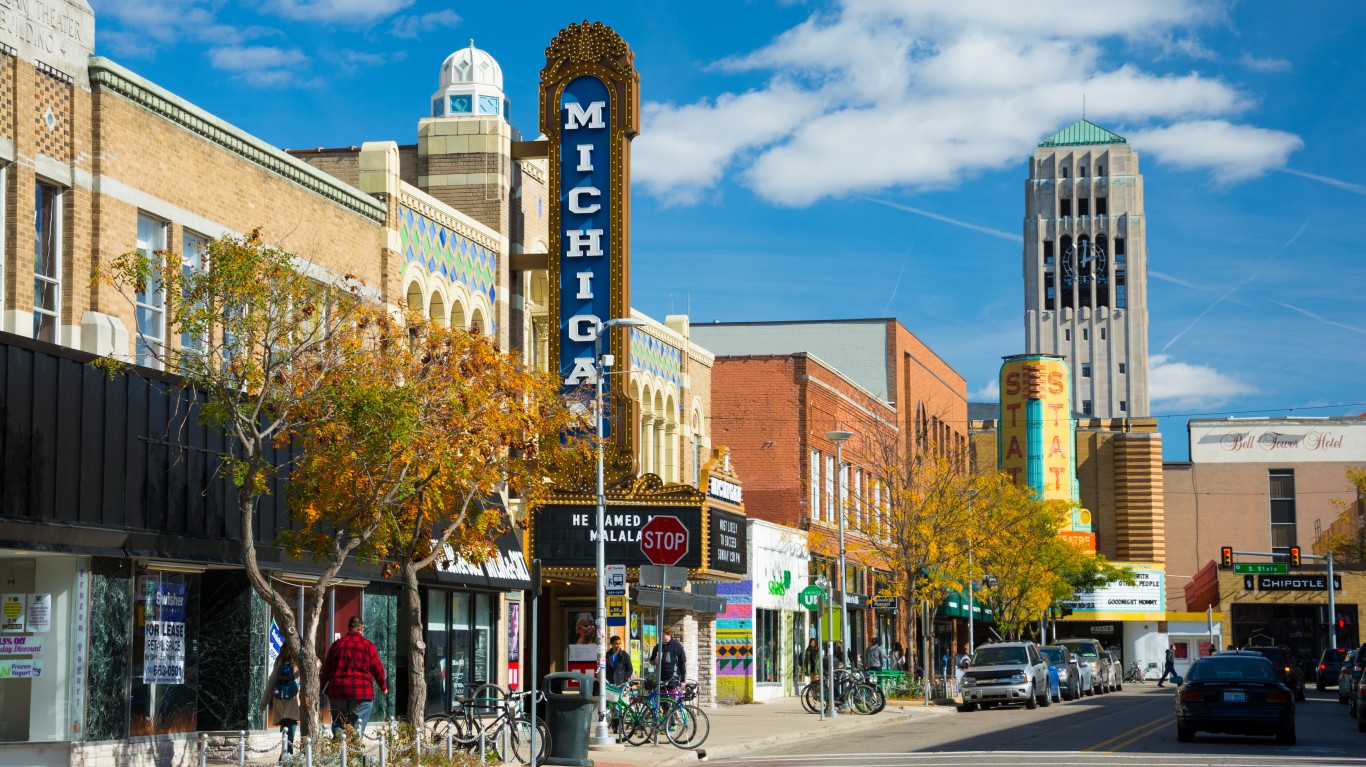
Michigan: Ann Arbor
Avg. new daily cases in Ann Arbor in week ending Feb. 15: 21.3 per 100,000
Avg. new daily cases in Ann Arbor in week ending Feb. 8: 26.1 per 100,000
COVID-19 cases in Ann Arbor as of Feb. 15: 17,982 (4,913.6 per 100,000)
Peak pandemic unemployment in Ann Arbor: 15.5% (April 2020)
Ann Arbor population: 365,961 (518.4 people per sq. mi.)

Minnesota: Mankato
Avg. new daily cases in Mankato in week ending Feb. 15: 23.4 per 100,000
Avg. new daily cases in Mankato in week ending Feb. 8: 15.4 per 100,000
COVID-19 cases in Mankato as of Feb. 15: 8,193 (8,184.4 per 100,000)
Peak pandemic unemployment in Mankato: 8.4% (May 2020)
Mankato population: 100,105 (83.7 people per sq. mi.)

Mississippi: Hattiesburg
Avg. new daily cases in Hattiesburg in week ending Feb. 15: 36.9 per 100,000
Avg. new daily cases in Hattiesburg in week ending Feb. 8: 40.9 per 100,000
COVID-19 cases in Hattiesburg as of Feb. 15: 16,080 (9,579.5 per 100,000)
Peak pandemic unemployment in Hattiesburg: 13.3% (April 2020)
Hattiesburg population: 167,859 (82.9 people per sq. mi.)

Missouri: Kansas City, MO-KS
Avg. new daily cases in Kansas City in week ending Feb. 15: 16.5 per 100,000
Avg. new daily cases in Kansas City in week ending Feb. 8: 20.8 per 100,000
COVID-19 cases in Kansas City as of Feb. 15: 135,382 (6,426.5 per 100,000)
Peak pandemic unemployment in Kansas City: 11.7% (April 2020)
Kansas City population: 2,106,632 (290.3 people per sq. mi.)

Montana: Great Falls
Avg. new daily cases in Great Falls in week ending Feb. 15: 24.7 per 100,000
Avg. new daily cases in Great Falls in week ending Feb. 8: 17.0 per 100,000
COVID-19 cases in Great Falls as of Feb. 15: 7,528 (9,209.0 per 100,000)
Peak pandemic unemployment in Great Falls: 12.6% (April 2020)
Great Falls population: 81,746 (30.3 people per sq. mi.)

Nebraska: Grand Island
Avg. new daily cases in Grand Island in week ending Feb. 15: 25.2 per 100,000
Avg. new daily cases in Grand Island in week ending Feb. 8: 31.8 per 100,000
COVID-19 cases in Grand Island as of Feb. 15: 8,139 (10,772.9 per 100,000)
Peak pandemic unemployment in Grand Island: 11.4% (April 2020)
Grand Island population: 75,551 (47.2 people per sq. mi.)

Nevada: Las Vegas-Henderson-Paradise
Avg. new daily cases in Las Vegas in week ending Feb. 15: 25.5 per 100,000
Avg. new daily cases in Las Vegas in week ending Feb. 8: 33.8 per 100,000
COVID-19 cases in Las Vegas as of Feb. 15: 222,670 (10,397.5 per 100,000)
Peak pandemic unemployment in Las Vegas: 34.2% (April 2020)
Las Vegas population: 2,141,574 (271.4 people per sq. mi.)
These are all the counties in Nevada where COVID-19 is slowing (and where it’s still getting worse).

New Hampshire: Manchester-Nashua
Avg. new daily cases in Manchester in week ending Feb. 15: 28.6 per 100,000
Avg. new daily cases in Manchester in week ending Feb. 8: 34.4 per 100,000
COVID-19 cases in Manchester as of Feb. 15: 27,315 (6,644.6 per 100,000)
Peak pandemic unemployment in Manchester: 17.5% (April 2020)
Manchester population: 411,087 (469.2 people per sq. mi.)

New Jersey: Atlantic City-Hammonton
Avg. new daily cases in Atlantic City in week ending Feb. 15: 50.5 per 100,000
Avg. new daily cases in Atlantic City in week ending Feb. 8: 55.5 per 100,000
COVID-19 cases in Atlantic City as of Feb. 15: 23,496 (8,749.6 per 100,000)
Peak pandemic unemployment in Atlantic City: 35.2% (June 2020)
Atlantic City population: 268,539 (483.2 people per sq. mi.)
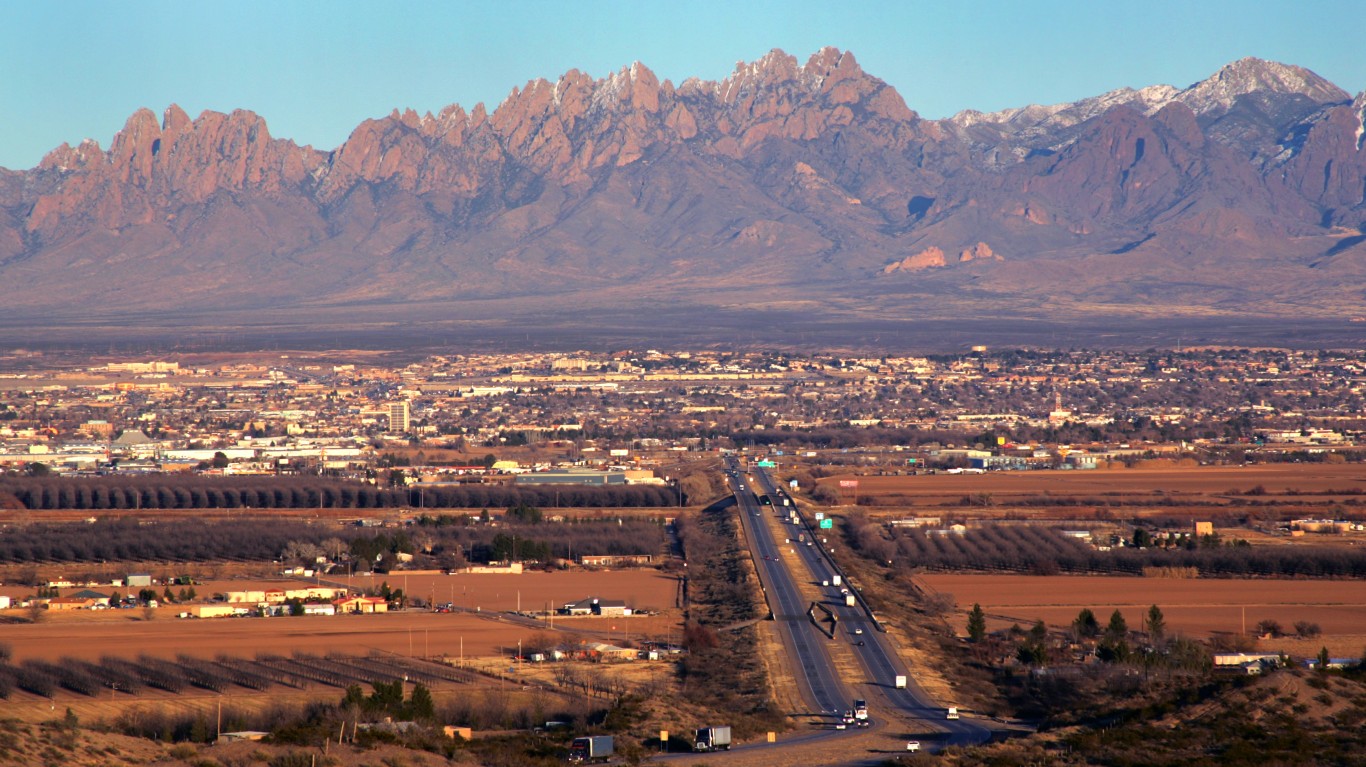
New Mexico: Las Cruces
Avg. new daily cases in Las Cruces in week ending Feb. 15: 30.7 per 100,000
Avg. new daily cases in Las Cruces in week ending Feb. 8: 32.0 per 100,000
COVID-19 cases in Las Cruces as of Feb. 15: 22,033 (10,231.8 per 100,000)
Peak pandemic unemployment in Las Cruces: 12.6% (July 2020)
Las Cruces population: 215,338 (56.6 people per sq. mi.)

New York: New York-Newark-Jersey City, NY-NJ-PA
Avg. new daily cases in New York in week ending Feb. 15: 49.2 per 100,000
Avg. new daily cases in New York in week ending Feb. 8: 51.1 per 100,000
COVID-19 cases in New York as of Feb. 15: 1,670,541 (8,647.4 per 100,000)
Peak pandemic unemployment in New York: 17.2% (June 2020)
New York population: 19,318,471 (2889.0 people per sq. mi.)

North Carolina: Rocky Mount
Avg. new daily cases in Rocky Mount in week ending Feb. 15: 56.3 per 100,000
Avg. new daily cases in Rocky Mount in week ending Feb. 8: 95.1 per 100,000
COVID-19 cases in Rocky Mount as of Feb. 15: 13,686 (9,289.0 per 100,000)
Peak pandemic unemployment in Rocky Mount: 14.2% (May 2020)
Rocky Mount population: 147,335 (140.9 people per sq. mi.)

North Dakota: Bismarck
Avg. new daily cases in Bismarck in week ending Feb. 15: 11.4 per 100,000
Avg. new daily cases in Bismarck in week ending Feb. 8: 15.6 per 100,000
COVID-19 cases in Bismarck as of Feb. 15: 19,508 (15,468.1 per 100,000)
Peak pandemic unemployment in Bismarck: 9.5% (April 2020)
Bismarck population: 126,118 (29.5 people per sq. mi.)

Ohio: Cincinnati, OH-KY-IN
Avg. new daily cases in Cincinnati in week ending Feb. 15: 35.3 per 100,000
Avg. new daily cases in Cincinnati in week ending Feb. 8: 48.4 per 100,000
COVID-19 cases in Cincinnati as of Feb. 15: 193,967 (8,850.2 per 100,000)
Peak pandemic unemployment in Cincinnati: 14.5% (April 2020)
Cincinnati population: 2,191,667 (481.4 people per sq. mi.)
These are all the counties in Ohio where COVID-19 is slowing (and where it’s still getting worse).
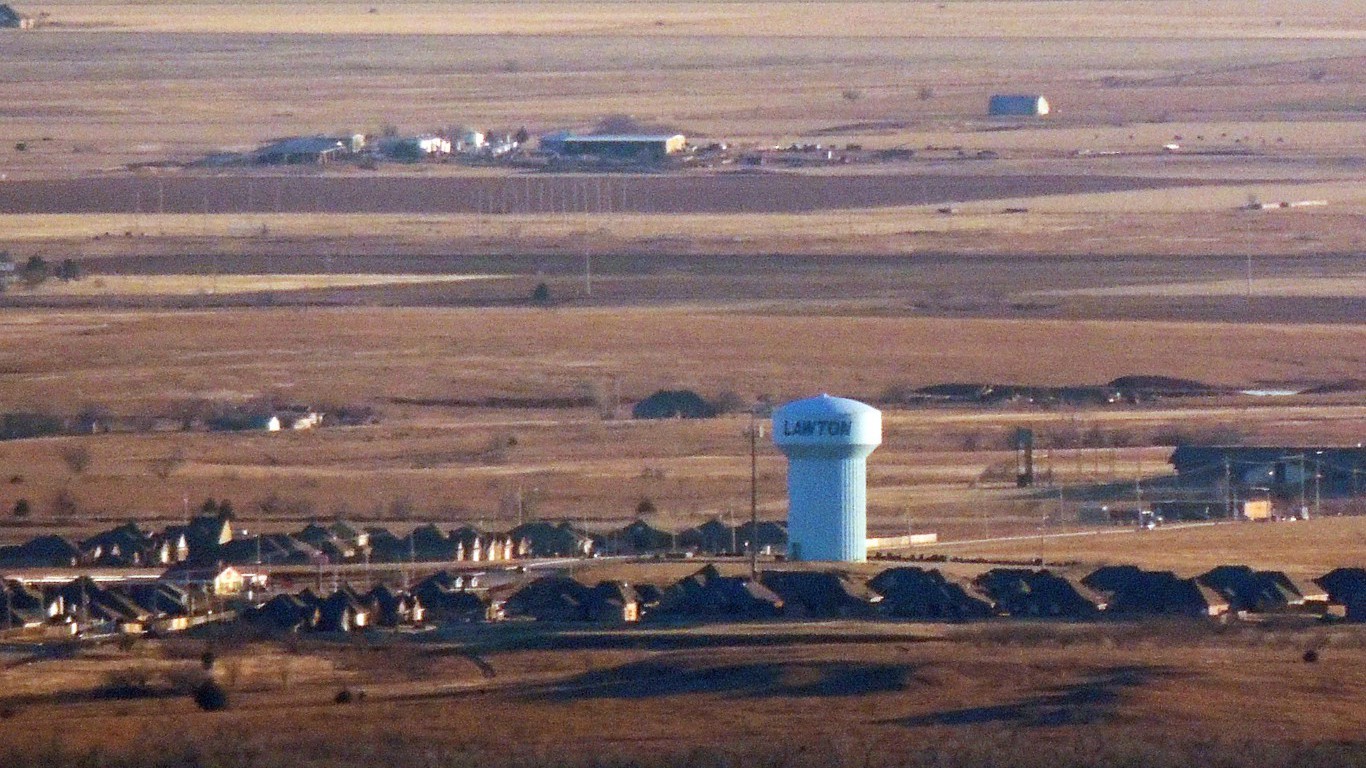
Oklahoma: Lawton
Avg. new daily cases in Lawton in week ending Feb. 15: 60.6 per 100,000
Avg. new daily cases in Lawton in week ending Feb. 8: 92.2 per 100,000
COVID-19 cases in Lawton as of Feb. 15: 12,108 (9,423.3 per 100,000)
Peak pandemic unemployment in Lawton: 19.5% (April 2020)
Lawton population: 128,490 (75.5 people per sq. mi.)

Oregon: Corvallis
Avg. new daily cases in Corvallis in week ending Feb. 15: 20.5 per 100,000
Avg. new daily cases in Corvallis in week ending Feb. 8: 19.5 per 100,000
COVID-19 cases in Corvallis as of Feb. 15: 2,151 (2,395.9 per 100,000)
Peak pandemic unemployment in Corvallis: 10.6% (April 2020)
Corvallis population: 89,780 (132.8 people per sq. mi.)
These are all the counties in Oregon where COVID-19 is slowing (and where it’s still getting worse).

Pennsylvania: Williamsport
Avg. new daily cases in Williamsport in week ending Feb. 15: 44.7 per 100,000
Avg. new daily cases in Williamsport in week ending Feb. 8: 44.1 per 100,000
COVID-19 cases in Williamsport as of Feb. 15: 8,838 (7,694.7 per 100,000)
Peak pandemic unemployment in Williamsport: 17.4% (April 2020)
Williamsport population: 114,859 (93.5 people per sq. mi.)

Rhode Island: Providence-Warwick, RI-MA
Avg. new daily cases in Providence in week ending Feb. 15: 42.0 per 100,000
Avg. new daily cases in Providence in week ending Feb. 8: 57.4 per 100,000
COVID-19 cases in Providence as of Feb. 15: 163,139 (10,098.3 per 100,000)
Peak pandemic unemployment in Providence: 18.5% (April 2020)
Providence population: 1,615,516 (1018.0 people per sq. mi.)

South Carolina: Spartanburg
Avg. new daily cases in Spartanburg in week ending Feb. 15: 85.3 per 100,000
Avg. new daily cases in Spartanburg in week ending Feb. 8: 99.6 per 100,000
COVID-19 cases in Spartanburg as of Feb. 15: 33,841 (11,198.4 per 100,000)
Peak pandemic unemployment in Spartanburg: 15.5% (April 2020)
Spartanburg population: 302,195 (374.0 people per sq. mi.)

South Dakota: Sioux Falls
Avg. new daily cases in Sioux Falls in week ending Feb. 15: 18.3 per 100,000
Avg. new daily cases in Sioux Falls in week ending Feb. 8: 19.0 per 100,000
COVID-19 cases in Sioux Falls as of Feb. 15: 36,892 (14,442.6 per 100,000)
Peak pandemic unemployment in Sioux Falls: 10.7% (April 2020)
Sioux Falls population: 255,438 (99.2 people per sq. mi.)

Tennessee: Cleveland
Avg. new daily cases in Cleveland in week ending Feb. 15: 52.2 per 100,000
Avg. new daily cases in Cleveland in week ending Feb. 8: 49.1 per 100,000
COVID-19 cases in Cleveland as of Feb. 15: 14,072 (11,597.3 per 100,000)
Peak pandemic unemployment in Cleveland: 14.3% (April 2020)
Cleveland population: 121,339 (158.9 people per sq. mi.)

Texas: Odessa
Avg. new daily cases in Odessa in week ending Feb. 15: 99.3 per 100,000
Avg. new daily cases in Odessa in week ending Feb. 8: 67.9 per 100,000
COVID-19 cases in Odessa as of Feb. 15: 15,616 (9,862.2 per 100,000)
Peak pandemic unemployment in Odessa: 16.5% (May 2020)
Odessa population: 158,342 (176.4 people per sq. mi.)
These are all the counties in Texas where COVID-19 is slowing (and where it’s still getting worse).

Utah: Provo-Orem
Avg. new daily cases in Provo in week ending Feb. 15: 38.3 per 100,000
Avg. new daily cases in Provo in week ending Feb. 8: 48.0 per 100,000
COVID-19 cases in Provo as of Feb. 15: 87,844 (14,877.7 per 100,000)
Peak pandemic unemployment in Provo: 8.1% (April 2020)
Provo population: 590,440 (294.7 people per sq. mi.)
These are all the counties in Utah where COVID-19 is slowing (and where it’s still getting worse).

Vermont: Burlington-South Burlington
Avg. new daily cases in Burlington in week ending Feb. 15: 19.1 per 100,000
Avg. new daily cases in Burlington in week ending Feb. 8: 20.0 per 100,000
COVID-19 cases in Burlington as of Feb. 15: 5,613 (2,574.3 per 100,000)
Peak pandemic unemployment in Burlington: 14.8% (April 2020)
Burlington population: 218,042 (174.1 people per sq. mi.)

Virginia: Richmond
Avg. new daily cases in Richmond in week ending Feb. 15: 49.6 per 100,000
Avg. new daily cases in Richmond in week ending Feb. 8: 48.4 per 100,000
COVID-19 cases in Richmond as of Feb. 15: 81,003 (6,437.0 per 100,000)
Peak pandemic unemployment in Richmond: 11.7% (April 2020)
Richmond population: 1,258,398 (288.4 people per sq. mi.)

Washington: Yakima
Avg. new daily cases in Yakima in week ending Feb. 15: 40.3 per 100,000
Avg. new daily cases in Yakima in week ending Feb. 8: 50.7 per 100,000
COVID-19 cases in Yakima as of Feb. 15: 25,909 (10,391.7 per 100,000)
Peak pandemic unemployment in Yakima: 14.6% (April 2020)
Yakima population: 249,325 (58.0 people per sq. mi.)

West Virginia: Wheeling, WV-OH
Avg. new daily cases in Wheeling in week ending Feb. 15: 32.9 per 100,000
Avg. new daily cases in Wheeling in week ending Feb. 8: 40.6 per 100,000
COVID-19 cases in Wheeling as of Feb. 15: 11,306 (7,924.9 per 100,000)
Peak pandemic unemployment in Wheeling: 17.7% (April 2020)
Wheeling population: 142,664 (151.2 people per sq. mi.)

Wisconsin: La Crosse-Onalaska, WI-MN
Avg. new daily cases in La Crosse in week ending Feb. 15: 19.3 per 100,000
Avg. new daily cases in La Crosse in week ending Feb. 8: 33.3 per 100,000
COVID-19 cases in La Crosse as of Feb. 15: 13,582 (9,949.2 per 100,000)
Peak pandemic unemployment in La Crosse: 11.7% (April 2020)
La Crosse population: 136,513 (136.0 people per sq. mi.)
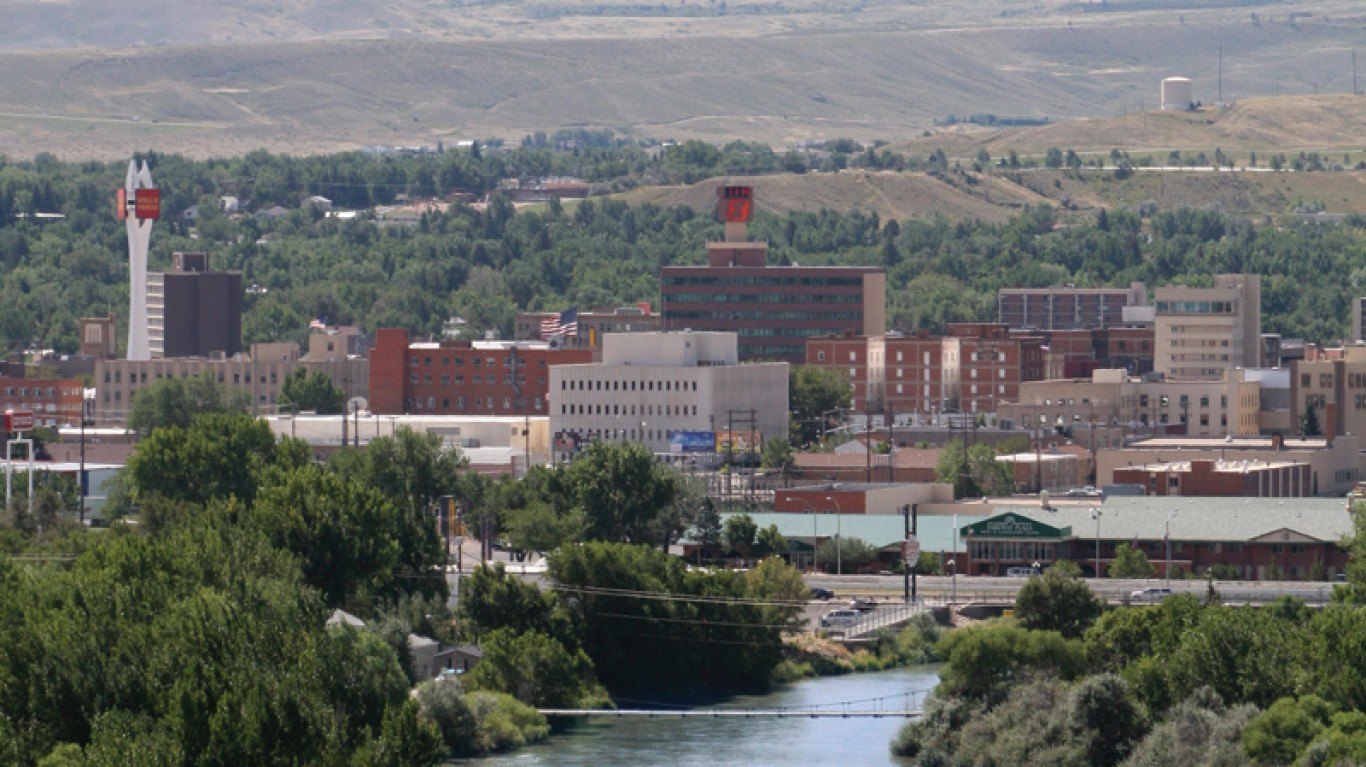
Wyoming: Casper
Avg. new daily cases in Casper in week ending Feb. 15: 7.2 per 100,000
Avg. new daily cases in Casper in week ending Feb. 8: 18.1 per 100,000
COVID-19 cases in Casper as of Feb. 15: 7,614 (9,445.5 per 100,000)
Peak pandemic unemployment in Casper: 12.6% (April 2020)
Casper population: 80,610 (15.1 people per sq. mi.)
Click here to see all coronavirus data for every state.
Thank you for reading! Have some feedback for us?
Contact the 24/7 Wall St. editorial team.